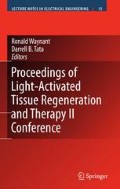Abstract
The roles of two different non-conventional techniques in suppressing the metabolic activity of a malignant human brain cancer (glioblastoma) cell line were explored through the application of (i) pulsed electric field, or (ii) independent application with a continuous wave broadband near infrared light channeled through a fiber-optic bundle exposing cancer cells within growth medium. Human glioblastomas were grown in T-75 flasks and were utilized when the cells were 50–70% confluent. The cells were either transferred into 96 well plates for exposures through a fiber bundle, or into 1.4 ml sterile eppendoff tubes for exposures to pulsed electric potential. The glioblastomas within wells were light exposed through a fiber bundle at an average intensity of 0.115 W/cm2 from the underside of the well, with the light dose (fluence) values ranging from 0.115—50 J/cm2. Glioblastomas exhibited a maximal decline in the metabolic activity (down 80%) relative to their respective sham exposed control counterparts between the fluence dose values of 5.0–10 J/cm2. The cellular metabolic activities for various treatment doses were measured through the colorimetric MTS metabolic assay 3 days after the broadband near infrared light exposure. Interestingly, the metabolic activity was found to return back to the (sham exposed) control levels as the fluence of exposure was increased up to 50 J/cm2. Glioblastomas in suspension within sterile eppendoff tubes were exposed to pulsed electrical potential fluctuations: rectangular pulse width = 250 ms with pulse amplitude = 100 V, with 8 square pulses per burst, 2 bursts per second. A time course study of treatment exposure revealed a complete obliteration of glioblastomas for in-vitro treatment duration beyond 7 min.
Access this chapter
Tax calculation will be finalised at checkout
Purchases are for personal use only
References
Tuner, J., Hode, L. 2002, Laser Therapy — Clinical Practice and Scientific Background. Prima Books AB, Grangesberg, Sweden. Biostimulation, Chapter 4.1.7: Cancer 130–134, and see table listing in Chapter 11 on page 349.
Tuner, J., Hode, L. 2002, Laser Therapy — Clinical Practice and Scientific Background. Prima Books AB, Grangesberg, Sweden. Chapter 3: Biostimulation, Chapter 4: Medical Indications.
Hamblin, M., Demidova, T.N., Mechanisms of low light therapy. Proc. SPIE. Vol. 6140, pp 1–12, 2006.
Zhang, Y., Song, S., Fong, C.C., Tsang, C.H., Yang, Z., Yang M. cDNA microarray analysis of gene expression profiles in human fibroblast cells irradiated with red light. J. Invest. Dermatol., Vol. 120, pp 849–857, 2003.
Lubart, R., Lavi, R., Friedmann, H., Rochkind, S. Photochemistry and photobiology of light absorption by living cells. Photomed. Laser Surg., Vol. 24, pp 179–185, 2006.
Yu, W., Naim, J.O., McGowan, M., Ippolito, K., Lanzafame, R.J. Photomodulation of oxidative metabolism and electron chain enzymes in rat liver mitochondria. Photochem. Photobiol. Vol. 66, pp 866–871, 1997.
Passarella, S. Helium — neon laser irradiation of isolated mitochondria. J Photochem Photobiol B, Vol. 3, pp 642–643, 1989.
Hawkins, D., Abrahamse, H. Biological effects of helium — neon laser irradiation on normal and wounded human skin fibroblast. Photomed Laser Surg, Vol. 23, pp 251–259, 2005.
Rubinsky, B., Onik, G., Mikus, P. Irreversible electroporation: a new ablation modality — clinical implications. Technol Cancer Res Treat, Vol. 6, pp 37–48, 2007.
Miller, L., Leor, J., Rubinsky, B. Cancer cells ablation with irreversible electroporation. Technol Cancer Res Treat, Vol. 4, pp 699–705, 2005.
Author information
Authors and Affiliations
Editor information
Editors and Affiliations
Rights and permissions
Copyright information
© 2008 Springer Science+Business Media, LLC
About this paper
Cite this paper
Tata, D.B., Waynant, R.W. (2008). Independent Applications of Near-IR Broadband Light Source and Pulsed Electric Potential in the Suppression of Human Brain Cancer Metabolic Activity: An In-Vitro Study. In: Waynant, R., Tata, D.B. (eds) Proceedings of Light-Activated Tissue Regeneration and Therapy Conference. Lecture Notes in Electrical Engineering, vol 12. Springer, Boston, MA. https://doi.org/10.1007/978-0-387-71809-5_31
Download citation
DOI: https://doi.org/10.1007/978-0-387-71809-5_31
Publisher Name: Springer, Boston, MA
Print ISBN: 978-0-387-71808-8
Online ISBN: 978-0-387-71809-5
eBook Packages: EngineeringEngineering (R0)

